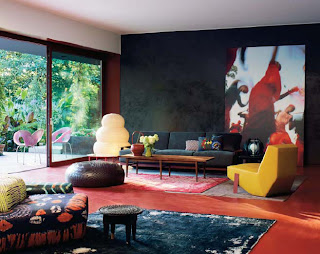by Pilar Viladas for The New York Times T Magazine.
Patrizia Moroso is the creative director of Moroso, the 58-year-old company in Udine, Italy, that is one of the last remaining family-owned furniture manufacturers in a country that was once famous for them. A petite, intense figure — a kind of den mother in Issey Miyake — who loves to nurture new talent, she helped propel designers from Ron Arad and Massimo Iosa Ghini to Tord Boontje and Tokujin Yoshioka onto the global stage by commissioning envelope-pushing chairs, sofas and tables from them.
Patricia Urquiola is a vivacious Spanish architect and designer whose rapid-fire conversation includes multilingual superlatives like “super-carino” (“super-cute”) and “molto timeless.” And thanks to her work for furniture companies like Moroso, Kartell and B&B Italia, Urquiola, whose nine-year-old studio is based in Milan, has rocketed to super stardom in the last few years. Her recent projects include bathtubs for Axor, hotels for the W and Mandarin Oriental chains, a new store for H&M that opens in London next month and sets for a production of Monteverdi’s opera “L’Incoronazione di Poppea” in her hometown of Oviedo, Spain.
Moroso and Urquiola are both smart, opinionated, strong-willed women. So what happened when the former commissioned the latter to design a house? The result is a surprisingly serene and airy structure with colorful, welcoming interiors. On the outside, cedar siding and deep red trim make the 10,000-square-foot structure almost disappear into its heavily wooded setting; on the inside, ample windows let nature into the sheltering spaces. What is more, the house is environmentally conscious, with thick, ventilated and cork-insulated walls, solar panels for heating and hot water, and radiant-heated floors, as well as a large cistern for watering the plants, and outdoor pavers made from recycled steel waste.
“The first time I came here, it was spring,” Moroso said of her initial visit to the site. Having lived for a long time in an old house in the center of Udine, a city of about 100,000 in northeast Italy, Moroso decided that she wanted a change of domestic scenery for herself, her husband, Abdou Salam Gaye, and their three children. One day she noticed “a sort of wild garden” on a secluded street. It happened to be for sale, and — even better — it bordered public parkland that could never be developed. “I thought it was an earthly paradise,” Moroso recalled. Her husband agreed, and Patrizia called Patricia. “I liked her product design,” Moroso explained, “and she’s a woman. I thought I could talk to her about my ideas.” Urquiola designed the house in collaboration with the Milan architect Martino Berghinz, with whom she worked from 2001 to 2008. (Urquiola’s business partner is now Alberto Zontone, who is also her companion.)
“She’s a big bohemian,” Urquiola said of her client, who studied art before joining the family business nearly three decades ago. The house was thought of “from the inside out,” to accommodate the family’s busy social life. In Gaye’s native Senegal, entertaining groups of extended family and friends is common, so the house’s first floor contains its more public spaces: a catering kitchen, guest room, hammam and indoor pool; a playroom for the children; and two seating areas — one, with Urquiola-designed upholstered furniture and contemporary Iranian rugs, that opens onto a terrace, and the other a conversation pit that Moroso calls “our African place,” for eating and listening to music.
Upstairs are the family quarters — a smaller living room, a dining room and much smaller kitchen, and bedrooms. Urquiola said of the arrangement, “The house is about how to create an Italian-Senegalese landscape.” Of its formal language, she added: “The house has a kind of severity. So you can put a lot of things in it.”
Indeed, the interiors are a portrait in restrained clutter: artful groupings of tables and stools, sofas and chairs, pillows, vases and bowls. The art includes a giant light box by Fathi Hassan and an oversize photograph by Boubacar Touré Mandémory — two contemporary artists who were featured in Moroso’s influential “M’Afrique” exhibition during the 2009 Milan furniture fair — as well as boldly colored canvases by Gaye, who, in addition to painting, oversees the production of the M’Afrique furniture collection.
Some of the furniture is one of a kind, like the painted metal chairs by Ron Arad, but there are Moroso prototypes, too, like the Rift sofa by Urquiola covered in African fabric, which sprawls in the downstairs sitting room. Some pieces are simply rejects, like the Arad-designed plastic Ripple chairs on the terrace. Their colors, muddled in the molding process, made them even more appealing to Moroso. “I like the ‘strange’ version,” she explained, “the mistakes from the factory, the unique pieces made by the industrial process.” Her house, she said, is “sort of a testing place for me,” and “an extension of what I do.”



























